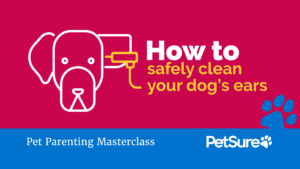At-home dental care for your dog starts with tooth brushing. Like humans, your dog’s teeth and gums need regular attention.
Mouth checks are also important because if a problem is brewing under the surface, you’ll be more likely to spot it sooner rather than later.
Regardless of how well-balanced your pet’s diet is, plaque can form. Plaque is the result of food residue, bacteria and saliva. Plaque is a sticky substance that coats the teeth and if not brushed away, can harden. Hardened build-up (tartar) can cause early-stage gum disease which can progress to periodontal disease, the most advanced stage resulting in lost teeth.
FAQs: Brushing your dog’s teeth – what you need to know
Chances are your pet hasn’t had their teeth brushed before, so it’s your job as a pet parent to teach them. First, take a few days to allow your pet to become comfortable with being touched around the muzzle and gums. Then, if there is no sign of tension, lift the upper and lower lips to run your fingers back and forth over the teeth, mimicking the motion of a toothbrush. Once acclimatised, introduce a toothbrush and paste.
While there are specially made pet toothbrushes, the type of toothbrush to choose may depend on your pet. Smaller pets could fare better with a finger brush, a toothbrush designed to slide onto the finger. If you have a larger pet, brushing their teeth is easier with a long-handled brush. Ensure the brush head is small, angled, and soft-bristled.
In short, no. Human toothpaste may contain harmful ingredients like Xylitol, which can be poisonous to dogs. Also, unlike pet formulations, human toothpaste isn’t made to be swallowed. The added benefit of toothpaste designed for dogs is some come in pet-friendly flavours like chicken and beef. If your pet really does not like pet toothpaste, brushing with a wet toothbrush is still much better than not brushing at all.
Brushing teeth twice a day is recommended, but even once a day will help keep your pet’s teeth and gums healthy, strong and plaque-free. Aim for a couple of minutes each time you brush.
When brushing your dog’s teeth, you need only brush the outer surface. Brush teeth from front to back, including the upper and lower teeth, with a downward motion. Remember: only use a small amount of pet toothpaste and be gentle.
Healthy dog gums – gums are a light-coloured pink. While some breeds might have spotted or darker-coloured gums, the gums should be free of swelling or inflammation.
· Gums should be slightly moist – Healthy gums should be slippery and feel smooth to the touch.
· Minimal odour – If your dog has bad breath (halitosis), this may indicate dental disease.
· Tooth discolouration – watch for yellow or brown tartar around the top of the tooth near the gum line.
· Broken teeth – Chewing bones, accidents, or other trauma can cause broken teeth. Please consult with your vet for more information.
Reference/source articles:
https://www.petculture.com.au/articles/guide-to-dog-teeth
https://bowwowinsurance.com.au/pet-community/pet-talk/how-to-brush-your-dogs-teeth/
https://www.medibank.com.au/livebetter/be-magazine/pet/looking-after-your-pets-teeth/
Pet insurance can help by covering a portion of the eligible vet bill if the unexpected happens. Because it is difficult to predict the costs of veterinary care, it can help to have measures in place to help prepare for the unexpected. Check out our partner network and explore our policy tools to find a pet insurance policy.
Not all conditions or items are covered by Pet Insurance. Refer to the applicable Product Disclosure Statement for information about coverage and exclusions.



 Fact checked
Fact checked



